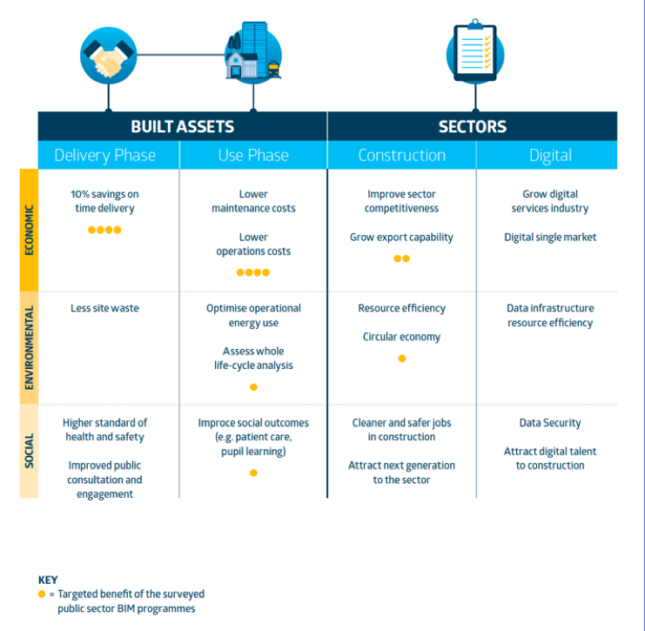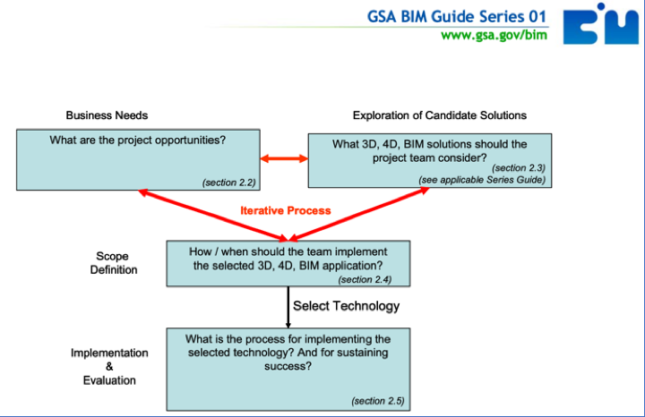During my days as a technology vendor, I chafed at the idea of introducing government standards for technology developed by a polyglot group of stakeholders. Users, software companies, and bureaucrats often sought a “lowest common denominator” between various software, sacrificing innovation and progress for vague notions like “open access.” In the early days of Building Information Modeling (BIM), several such efforts emerged, the most prominent of which were the General Services Administration (GSA) attempts to create a standard and the development of BIM-derived digital permitting submissions in Singapore. Both projects garnered much attention but gained little traction in the form of implemented technologies or operating protocols—at least in their early forms. But they had one important effect: In the loosely organized, disparate network of the building industry supply chain, government could provide a galvanizing influence. At least when government spoke, the industry listened.
In 2011, however, we witnessed a welcome change with the publication of the United Kingdom’s “Government Construction Strategy.” Much of the early theory about industry productivity and need for process integration had long emerged from that side of the Atlantic—for example, Sir Roger Egan’s seminal “Rethinking Construction” report—but there was little action. The David Cameron government, however, saw construction as a critical economic engine, concluding that improving the cost and carbon impacts of building while bolstering U.K. capabilities as a global building leader would drive growth. One pillar of the resulting government policy document was BIM, and the following requirement: “2.32. Government will require fully collaborative 3-D BIM (with all project and asset information, documentation, and data being electronic) as a minimum by 2016. A staged plan will be published with mandated milestones showing measurable progress at the end of each year.”
As upwards of 40 percent of construction dollars in the U.K. are spent by the government, the industry snapped to attention, formed cross-industry collaborations, and established and implemented BIM requirements for all their projects (with logistical and financial support from the government). BIM adoption shot up from 10 percent in 2012 to 70 percent by 2018, and savings on the first prototype projects were estimated at as much as 2.5 percent of the total lifetime cost of designing, building, and operating the project. By my own estimate, that’s as much as five times the fees likely paid to the design team and 25 percent of original construction cost. Not bad for a first effort. And, in typical British fashion, the resulting standards (search online for “PAS 1192”) were clear, rigorous, and implementable.
The success of the U.K. effort has spread across Europe, and EU government leaders have taken similar roles (at least until Brexit) in developing standards for the entire European Union, while also establishing footholds with other global networks, most notably in Latin America and Southeast Asia. Singapore, in collaboration with the U.K. team, has spurred a multiyear effort to create a standards collaboration there. As we approach the end of the second decade of BIM, one can see the slow emergence of a global network of BIM standards leading to a single market BIM, catalyzed by what may be the only cohering force in the building universe: the long arm of the law.
Now that the technology is mature and its use stable, global BIM standards are a good thing. The U.K. effort rightly became the basis of a worldwide standard created by the International Organization for Standardization (ISO; see ISO Standard 19650) and released in early 2019. Based on the now viral PAS 1192, ISO describes its work as “recommended concepts and principles for business processes across the built environment sector in support of the management and production of information during the life cycle of built assets (referred to as ‘information management’) when using building information modelling (BIM).” Note the emphasis on business process driving the technology standard; precisely the right relationship for creating a stable platform for the otherwise disparate players in the global building industry.
Adoption Process Diagram from the GSA BIM Guide Series 01 (2007). (Courtesy GSA BIM Guide Series 01)
And there’s an even larger idea here. What’s most powerful about the U.K.’s trailblazing work on BIM standards is the origin point: Rather than start with the prosaic, bottom-up question of lowest common denominator tech standards, they chose a broad organizing principle—improving building through technology is good for the economy and the environment, and doing this in a way that is agnostic to specific technologies or proprietary software drives competitive innovation that helps the entire market.
Driving BIM standards has further benefits to government, not the least of which is transactional transparency. State-run construction is rife with overbidding, conflicts of interest, and corruption. A bedrock principle of “collaborative 3-D BIM” is information clarity—all members of the building team can see and understand the physical and technical characteristics of the project in parametric three dimensions, along with the resulting arithmetic of cost projection—which makes it that much harder to manipulate a bid.
In the early days of the U.K. project there was an appointed Chief Government Construction Advisor with a direct line to high-level policy makers in the Cabinet. The United States’ construction market, roughly five times the size of the U.K.’s, could surely benefit from some policy-driven federal leadership, something that is certainly hard to imagine in today’s administration and go-go economy. But when the inevitable downturn does occur, we’ll know which way to look for inspiration for industry improvement.
For more on the latest in AEC technology and for information about the upcoming TECH+ conference, visit techplusexpo.com/nyc/.


